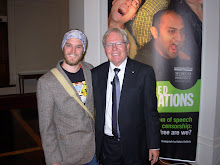My fear continued unabated once the film started, as the same piece of music opens the movie. It is an incredible piece, made even more amazing by the fact that the music was composed by Carpenter himself (given he directed and co-wrote as well, that makes this quite the auteur piece). This leads into one of the best opening halves in film history. The tension throughout is astounding and unrelenting. The opening credits are surely some of the best ever, establishing this tension I am talking about and featuring one creepy fucking Jack O’ Lantern. Check them out:
From here we jump into an opening scene where the soundtrack makes it nigh on unwatchable. First person, point of view shooting seems like such a tacky cliché these days and it is rarely used well. In the hands of most directors it seems like a ‘wow, see this fancy shot I am doing here hint hint nudge nudge’ gesture, instead of being employed for a reason. Here it is used to devastating effect. This first scene really is sheer genius. Big SPOILER alert – the shot comes from the murderer’s point of view. So the audience’s view is restricted to only what he can see as he climbs the stairs. Then in a masterstroke, the view is further obscured when the killer puts on a mask. You will find yourself straining to see things just outside the killer’s vision. For a moment after the first person murder all you can hear is the heavy breathing. And then comes the big reveal as the mask is removed, and the camera wheels around to reveal just how young the murderer is. Really stunning stuff, and a reminder to me just why I love watching film and watching films outside the kind I would usually be attracted to.
After this opening sequence the plot jumps forward 15 years. The killer Michael has been locked up for that entire time, and has not spoken a word. He returns to the town he grew up on a Halloween evening, and is intent on wreaking more havoc. This film is all about control, the control that Carpenter as director wields over his audience. In addition to the mask already mentioned in the opening scene, various camera angles and things such as car windshields and even just darkness are used to control the frame and only allow the audience to see what he wants us to. It is such a simple technique, but one that works so very well. The director perfectly controls how much of the villain he wants us to see at any particular time. Sometimes his body just impinges on the frame slightly, just to remind us that he is there. The audience is repeatedly toyed with as Carpenter refuses to show all of the villain. Also key to Carpenter’s control is the incredible use of soundtrack. I really can’t emphasise enough how brilliantly this is done. It may be the best use of soundtrack I’ve ever witnessed, no exaggeration. There is the recurring piece of music that I have already mentioned which is used to herald the villain’s presence. Which sounds like it would give too much away, but instead enhances the malevolent nature of him. As well as music there are also a couple of audio motifs employed, such as the villain’s heavy breathing which is chilling as it emanates from behind closed doors and the like. It is strange how even though you are aware that the music and the breathing mean the bad guy is around, it can still elicit such tension from the situations rather than breed familiarity. The use of all the music and audio cues is also so beautifully measured, when it could have so easily been overblown.
This film “introduces” Jamie Lee Curtis (of course her mother Janet Leigh starred in Psycho (1960) a film Halloween has often been compared to), and you have to thank it for that. She has such a nice, clever screen presence which is evident, even from this early age. In fact all the young female actors who inhabit this film are quite good. Considering the type of films that Halloween is accused of inspiring, it is almost a surprise that there only about four or so murders in the whole film, and they are not that graphically shot given today’s standards. Much of the body of the film is Michael in the car, driving around, stalking his would be victims as his creepyarse music plays. It is a slow, suspenseful build that creates a fantastically intimidating atmosphere. This is created in what is meant to be a slice of typical American suburbia. But it also comments upon the coldness of modern society. There is a harrowing scene where a distraught teen screams her lungs out for help, but her neighbours simply ignore her, some going actively out of their way to avoid assisting. It could be argued that this build goes on a little too long, but I think I would prefer that to an alternative of mindless killing with no explanatory build-up. And in a strange way, once the killing starts the film actually gets somewhat less scary rather than more. That is not to say there is not still the odd fright, including the biggest of the entire film. The second half is not as satisfying as the first. This is partly because it is slightly inferior, but also happily because the first stanza is absolutely phenomenal.
If you know anyone silly enough to believe that the auteur and genre are mutually exclusive, show them this film and show them how wrong they are. I highly recommend watching this on Halloween night if you are keen for a horror flick. You’ll probably be scared at some stage, but even if not you will be treated to incredibly high class filmmaking.
Verdict: Longneck of Melbourne Bitter
Progress: 44/1001
